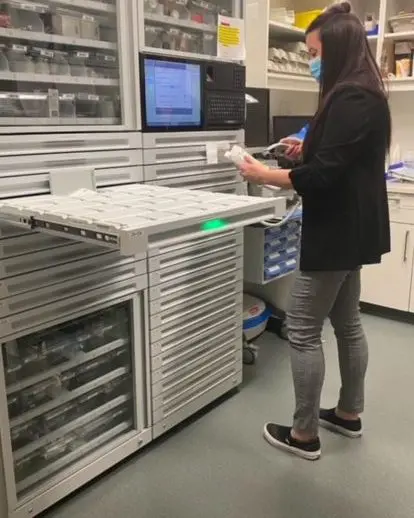Thus far, the past month has been the highlight of my Stenberg Pharmacy Technician program. I’ve been experiencing what it feels like to work in a hospital pharmacy first-hand, and it has been far more enjoyable than I was expecting. The hospital practicum portion of this program is four weeks straight and is an excellent opportunity to practice all the skills that I have learned since September.

Day one on the job
I wasn’t sure what to expect when I walked into the hospital pharmacy for the first time. I’ve been in hospitals before, but never inside the pharmacy. I expected to see many shelves lined with medications, some of which would be familiar and others that likely wouldn’t. I knew that I would see computers, printers, and typical office supplies but I was most looking forward to seeing the cleanroom.
The cleanroom is where all the IV bags and sterile compounds are mixed. The air quality is strictly monitored, and the cleaning protocols are of the highest standard. Personal protective equipment (PPE) and aseptic handwashing techniques are mandatory before anyone can enter the cleanroom. Before I was allowed, I was required to do three sets of gloved fingertip samplings. This is where you wash your hands, don your PPE, and place your fingertips (one by one) in the center of a test strip to incubate for 72 hours. If, after 72 hours, your test strip shows bacteria growth, you would need to improve your handwashing technique and try again. Mine showed up clean on all three attempts, which allowed me to observe my on-site monitor in the cleanroom by the second week.
Patient order entry

There are many different tasks that Pharmacy Technicians complete in a hospital pharmacy. I had the opportunity to gain experience in order entry. Doctors meet with patients in the wards and write patient medication orders, which are scanned to the pharmacy. Pharmacy Technicians enter these into the computer to allow the nurses to access the medications in the automated dispensing machines.
As a hospital Pharmacy Technician, you don’t typically spend much time directly with patients. As I entered patients’ orders into the system, I found myself intrigued with their names and ages, curious about their stories and what brought them into the hospital. Did the 100-year-old lady have any family to visit? Did the man with the amputation have anyone to help him at home? I was very interested in the patients, their medications, and their diagnoses.
IV bags and mathematical equations
Another task that I spent time on was gathering the necessary supplies for the IV bags to be mixed in the cleanroom the following day. I would do the administrative portion, such as printing documents and labels for the IV bags, emailing Pharmacists for approval, and completing the necessary forms. I would then do the mathematical portion, which included calculating how many vials of medication and IV bags are needed for the recommended duration of therapy.
On day one, I struggled to wrap my brain around all the steps, but I became very comfortable with this task by the end of the four weeks and thoroughly enjoyed it.
My Favourite: Automated Dispensing Cabinets

If I had to choose my favourite task, it would be working with the Omnicell machines. The Omnicell is an automated dispensing cabinet that stores medications for the nursing team. The pharmacy staff receives inventory reports based on the medications needed in the Omnicell machines, finds the medications in the pharmacy and brings them to the Omnicells in the different wards. Each ward requires a slightly different stock depending on the type of patient. For example, the emergency room requires different medications than the labour and delivery ward, so the inventory printouts are very handy when restocking.
One of my favourite moments during my practicum was when my monitor asked me to restock an item in the Omnicell. I was to find a specific medication on the pharmacy shelf and bring it to the machine. Each Omnicell drawer is locked, so I needed to use my memory as I could only unlock each drawer by entering the correct steps into the computer. I was elated when I remembered all the steps and reported my success to my monitor!
Great mentors
This practicum has been a great learning experience. I worked alongside three enjoyable individuals who I was sad to leave, but we will remain friends. They taught me many imperative aspects of working within a hospital pharmacy.
Both Pharmacy Technicians at the hospital where I completed my practicum went to Stenberg College and completed the same program I am currently enrolled in, so it was great to converse with them. We are all Alberta residents who completed a B.C.-based program, so it was helpful to hear them discuss the differences between B.C. pharmacy laws and Alberta pharmacy laws. I will need to know that information for my upcoming licensing exams.
What’s next?
Next up, I am very excited to participate in the five-week community practicum. I look forward to learning more about medications while also interacting with patients. Following my five-week practicum will be graduation! I am in disbelief that this journey is nearing an end, and a new one is about to begin!










